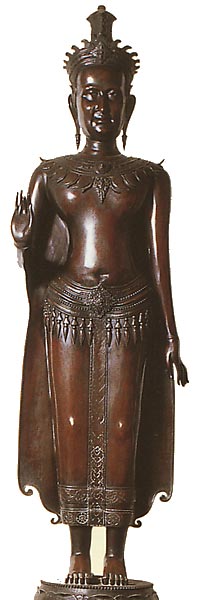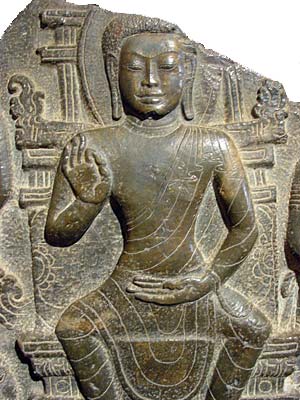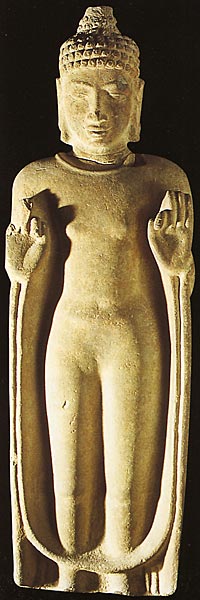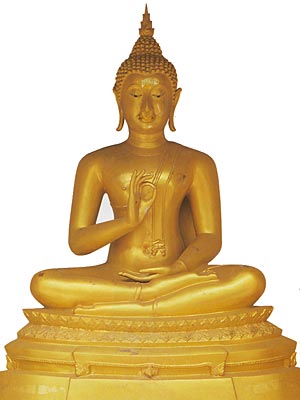Vitarka Mudra - Teaching, Instruction
Teaching, Giving Instruction, Reason.
The hand is held closer to the chest than in the Abhaya Mudra. The palm is facing outward. A circle is made with the index finger and the thumb. The other three fingers point upward. Initially made with the right hand, later on the gesture is often portrayed with both hands.
Common gesture in Dvaravati Buddha images.
Sometimes also substituted for the Dharmachakra Mudra (see below).
The Vitarka Mudra can be made while in sitting or standing position.

With the gesture (see right hand) of preaching. Cast and enlarged from an old model.
Image present in the cloister of the Ubosoth at Wat Benchamabophit, Bangkok.

Phra Pathom Chedi National Museum (Nakhon Pathom)
Original found at Wat Sai, Nakhon Pathom.

Found at Si Mahosot.
Now present at National Museum, Prachinburi.

The Buddha went to the Deer Park at Isipatana near Benares and preached his first sermon to a group of Five Disciples.
Buddha image at Phra Pathom Chedi.
![]() Characteristics and Postures of the Buddha
Characteristics and Postures of the Buddha
![]() Sitting Buddhas
Sitting Buddhas
![]() Reclining Buddhas
Reclining Buddhas
![]() Seven Days of the Buddha
Seven Days of the Buddha
Hand Gestures :
![]() The Six Main Mudras
The Six Main Mudras
![]() Dhyana Mudra
Dhyana Mudra
![]() Bhumisparsha Mudra
Bhumisparsha Mudra
![]() Abhaya Mudra
Abhaya Mudra
![]() Vitarka Mudra
Vitarka Mudra
![]() Varada Mudra
Varada Mudra
Historical Periods :
![]() Dvaravati
Dvaravati
![]() Khmer-Lopburi
Khmer-Lopburi
![]() Chiang Saen - Lanna
Chiang Saen - Lanna
![]() Sukhothai
Sukhothai
![]() U Thong
U Thong
![]() Ayutthaya
Ayutthaya
Historical Notes :
![]() Dvaravati
Dvaravati
![]() Sukhothai
Sukhothai
![]() Ayutthaya
Ayutthaya
![]() Resources
Resources
Temples in Thailand :
![]() Overview
Overview
![]() Wat Pho
Wat Pho
![]() Wat Benchamabophit
Wat Benchamabophit
Buddha Images at :
![]() Buddha Images at Wat Phra Pathom Chedi
Buddha Images at Wat Phra Pathom Chedi
![]() Introduction to Buddhism in Thailand
Introduction to Buddhism in Thailand
![]() The 10 Jatakas (lives of the Buddha) as depicted in Thai mural Temple paintings
The 10 Jatakas (lives of the Buddha) as depicted in Thai mural Temple paintings
More about Thailand at ThaiWebsites.com : Articles, and Web Directory
Content by Guido Vanhaleweyk, Bangkok.

.png)